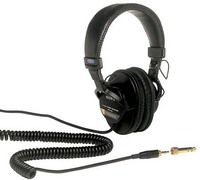![]() A cameraman would never judge composition and good lighting based on what he or she hears. Likewise, a soundperson would be a fool to record audio based solely on what they see. Yet all too often, that is exactly what many filmmakers do. They see their audio meters reacting, and therefore assume that good audio is being recorded.
A cameraman would never judge composition and good lighting based on what he or she hears. Likewise, a soundperson would be a fool to record audio based solely on what they see. Yet all too often, that is exactly what many filmmakers do. They see their audio meters reacting, and therefore assume that good audio is being recorded.
Headphones apparently only serve the purpose of keeping one's neck warm; besides, we all know that they mess up a good hair.
Am I just wisecracking? I wish I was, but sadly, there are way too many filmmakers out there who do not take monitoring their audio seriously. In the classes that I instruct, I will often (purposely) disconnect the audio feed from the mixer to the camera, and then ask everyone after the take, "How is everything? Picture good? Sound okay?"
 (left) Sony MDR-7506 Professional Headphones.
(left) Sony MDR-7506 Professional Headphones.
Long considered to be a standard of the industry.
More times than not, the camera operator (with headphones draped over their neck) will grin and give us a thumbs up! Perhaps the camerman stopped paying attention to any audio, and just concentrated on picture. Or maybe he/she just assumed that the live audio from the actors was what was being recorded. Bottom line: no usable audio.
There is absolutely no excuse for waiting until the shooting day is long over before evaluating the soundtrack. Thinking that the sound is fine is not the same thing as checking that the sound is fine. Use headphones; and playback some takes before you move on to the next major setup.
There are some very simple remedies. To begin with, the soundmixer, boom operator, and camera operator should all be wearing (over the ears, not around the neck) a pair of high quality headphones.
At least once every few takes, the boom operator should gently tap the mic with his finger, or slide his finger along the windscreen. Check with the camera operator to make sure that he hears that disturbance clearly in his headphones. If, for any reason the camera is not properly connected to the mixing panel or boom mic, it would be impossible for the cameraman to hear the finger tap. Ditto, if the camera somehow got switched to only pick up audio from the built-in camera mic.
Let's examine the issue of headphones. It is imperative that the soundperson invest in a high quality pair of Professional recording/engineering headphones, such as those made by Sony, Audio Technica, and Sennheiser.
Headphones intended for location audio recording share the following characteristics:
They need to fit comfortably OVER THE EARS, as opposed to just being a foam pad that sits against the ear. Professional headphones should provide a modicum of acoustic isolation by surrounding your earlobe with a cushioned pad.
The frequency response needs to be FLAT, so that what you record is what you hear. You do NOT want any headphones that "improve" the sound by boosting high or low frequencies, nor adding "concert hall" reverb. Avoid the so-called "noise canceling" headphones because they alter what you hear.
Impedance value for your phones should be between 40 ohms to 80 ohms. 50 to 65 ohms are most common. Less than 40 ohms and your audio will readily distort. Higher than 80 or so, and the volume will be too low. Remember, these headphones are intended to be used with field recorders and mixers; not home stereo receivers. Fancy 600 ohm headphones are fine for music listening at home because your powered stereo receiver puts out a very powerful signal; but plug them in to your camcorder and you will barely hear a thing.
Another spec to look at is the maximum wattage that the drivers (headphones) can accept before self-destructing. Many inexpensive headphones will blow out one or both sides if they are subjected to a short, but loud burst of audio (such as the ear-splitting crackle made by a faulty connection). Good headphones can accept a full watt or more without damaging. Cheaper phones can become worthless with hits of as little as one or two tenths of a watt!
